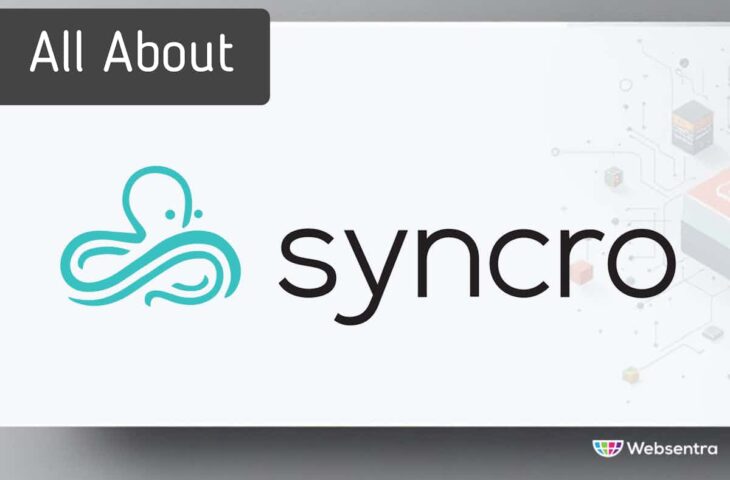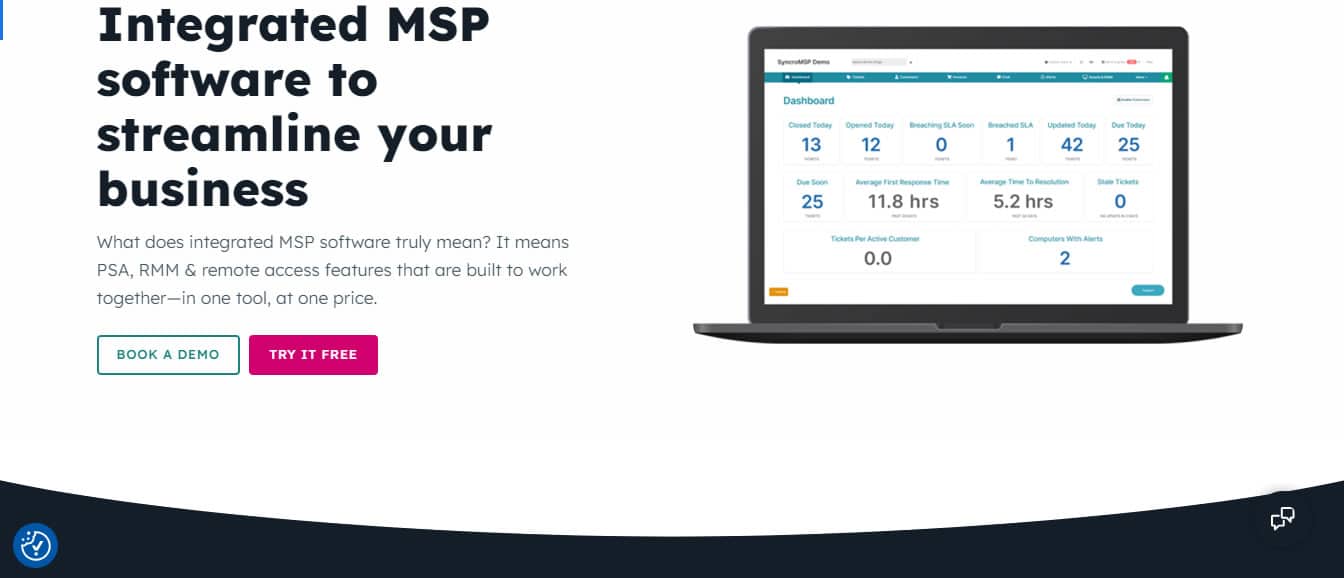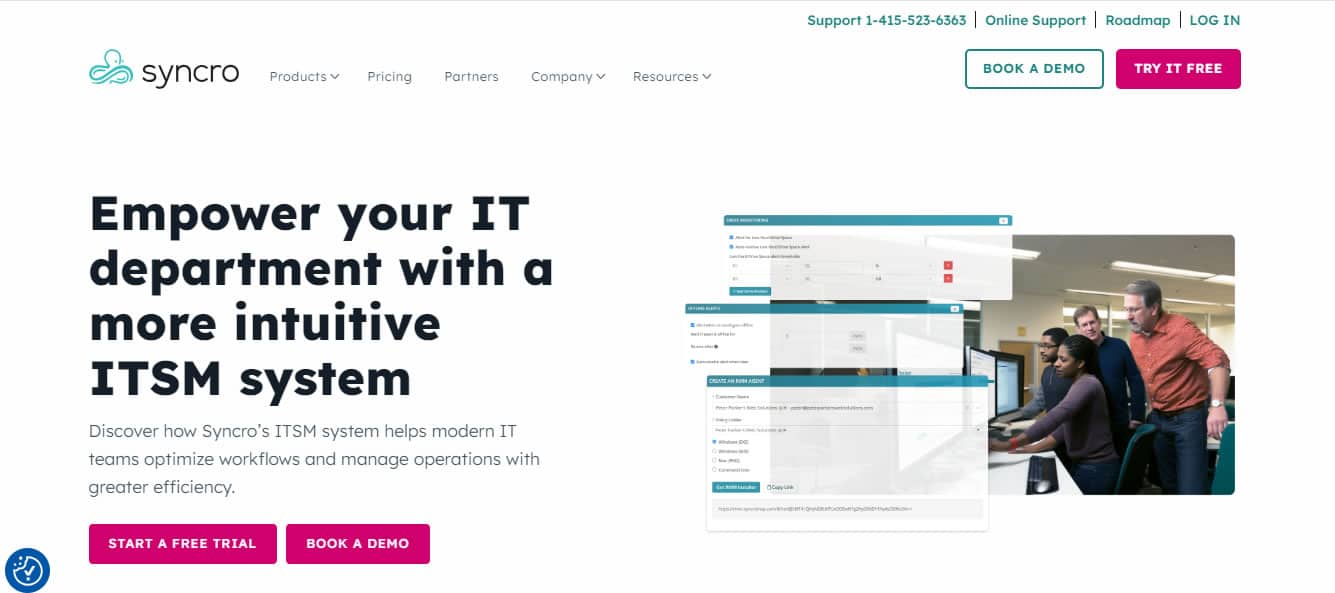We may earn a commission if you make a purchase through the links on our website.
All About Syncro

UPDATED: October 10, 2024
In the ever-evolving landscape of network management and IT service management, Syncro has carved out a notable position as a leading provider of integrated Remote Monitoring and Management (RMM) software. From its humble beginnings to its current status as an influential player in the IT management sector, Syncro’s journey is a testament to innovation, adaptability, and strategic growth. This article explores the origins of Syncro, its growth trajectory, and the evolution of its product suite. It also highlights key challenges the company has faced and showcases some of its flagship offerings.
Founding and Early Development
Syncro's origins goes back to the early 2000s, with the formation of two pivotal companies that laid the groundwork for what would become Syncro. The seeds for Syncro were sown in 2008 and 2011 with the creation of RepairShopr and RepairTech, respectively.
In 2008, Troy Anderson, a seasoned MSP business owner, and Desiree Delgado, an entrepreneur with a background in real estate, co-founded RepairShopr. Initially conceived as a solution to streamline service tracking and customer follow-up for their business, RepairShopr quickly evolved into a robust business management tool. Its success among break-fix repair shops highlighted a clear demand for efficient service management software.
In 2011, Ian Alexander, frustrated by the manual processes in his computer repair business, founded RepairTech. RepairTech's focus was on creating tools that addressed the needs of Managed Service Providers (MSPs) and IT service providers. With a $15,000 boost from a business plan competition, Alexander developed Kabuto, an RMM-like software product designed to automate IT service processes. However, this was just the beginning of a remarkable journey; a critical turning point lay ahead.
The Merger and Birth of Syncro
The pivotal turning point in Syncro’s history came in 2017 when RepairShopr and RepairTech merged. This strategic move combined their strengths—RepairShopr’s business management tools with RepairTech’s RMM capabilities. The merger of RepairShopr and RepairTech marked a significant turning point in the history of Syncro. The combined expertise of Troy Anderson, Desiree Delgado, and Ian Alexander created a strong foundation for the new platform.
The merger aimed to create a robust platform that would seamlessly integrate PSA and RMM functionalities, addressing the gap that existed in the market for a unified IT management solution. An octopus, symbolizing coordination and multitasking, was chosen as the logo, reflecting the platform’s ability to manage multiple aspects of IT and MSP operations simultaneously. The name “Syncro” underscored the goal of synchronizing various facets of an MSP’s business into a cohesive and efficient workflow.
Syncro Founders and Their Key Contributions
The story of Syncro is deeply intertwined with the vision and expertise of its founders. Their diverse backgrounds and shared commitment to improving IT management for MSPs laid the foundation for Syncro’s success. Here’s a detailed look at each founder and their key contributions:
Ian Alexander, with a background in computer engineering and hands-on experience in IT services, founded RepairTech in 2011 to address the inefficiencies he observed in IT service processes. His frustrations with manual workflows led him to develop Kabuto, an RMM-like software product aimed at automating IT management. Alexander's vision for reducing manual effort and improving efficiency became a cornerstone of Syncro’s product suite, with Kabuto laying a strong foundation for Syncro's RMM capabilities.
Troy Anderson, who owned an MSP called All In Networks, co-founded RepairShopr in 2008 alongside Desiree Delgado. RepairShopr was designed to overcome inefficiencies in service tracking and customer follow-up, directly addressing the needs he encountered in managing his MSP. The tool’s success among break-fix repair shops underscored Anderson’s deep understanding of the operational needs of IT service providers and his commitment to effective service management.
Together with Delgado, Anderson’s user-centric approach in creating RepairShopr significantly influenced Syncro's development. Their combined expertise and focus on addressing specific business needs ensured that RepairShopr’s integration into Syncro would build on a strong foundation of operational efficiency and user-centric design.
Timeline Of Key Events And Milestones
- Early Growth: Syncro’s initial years were marked by rapid growth and continuous improvement. The team focused on iterating the product based on feedback from early adopters. This iterative approach allowed Syncro to quickly adapt to the needs of its users and refine its offerings. By 2019, Syncro had established a strong presence in the market, driven by its commitment to listening to its user base and enhancing its platform accordingly.
- Expansion and Investment: The year 2020 was a turning point for Syncro. The COVID-19 pandemic posed uncertainties for many businesses, including Syncro. However, the company managed to not only weather the storm but also to thrive. Syncro experienced significant growth, doubling its annual recurring revenue from 2019 to 2020. This success attracted the attention of Mainsail Partners, who recognized the potential in Syncro’s approach and invested in the company. This investment was pivotal in scaling Syncro’s operations and accelerating its growth trajectory.
Here’s a detailed timeline of key events and milestones:
2008: The Birth of RepairShopr
- Founders: Troy Anderson and Desiree Delgado.
- Event: The inception of RepairShopr, a business management tool designed to streamline service tracking and customer follow-up for break-fix repair shops.
- Significance: This marked the beginning of what would later contribute to the formation of Syncro, addressing the need for efficient service management in the IT industry.
2011: The Founding of RepairTech
- Founder: Ian Alexander.
- Event: Launch of RepairTech, a company focused on creating RMM-like software, including the Kabuto product.
- Significance: RepairTech’s development of Kabuto aimed to automate IT service processes, providing a foundation for Syncro’s RMM capabilities.
2016: Initial Merger Discussions
- Event: RepairShopr and RepairTech began discussing a potential merger to combine their complementary products.
- Significance: These discussions set the stage for the creation of Syncro, as the two companies recognized the synergy between their solutions.
2017: Formation of Syncro
- Merger: RepairShopr and RepairTech officially merged to form Syncro.
- Event: Development and branding of Syncro began. An octopus was chosen as the logo, symbolizing the coordination of multiple business functions.
- Significance: Syncro was born as a unified platform combining PSA and RMM functionalities to serve MSPs more effectively.
2017: Product Branding and Development
- Event: The Syncro brand was developed, including the logo and visual identity.
- Significance: The branding reflected the platform’s goal of synchronizing various aspects of MSP operations, and the development team worked on building out the new product.
2018: Early Growth and Feedback Integration
- Event: Syncro started to gain traction in the market. The team focused on continuous improvement based on feedback from early adopters.
- Significance: The emphasis on listening to users and iterating on the product helped Syncro refine its offerings and address the needs of its customer base.
2019: Expansion and Product Enhancements
- Event: Syncro expanded its product suite with enhanced features, including advanced reporting and analytics.
- Significance: These improvements positioned Syncro as a more comprehensive solution for MSPs, adding value through deeper insights and better management tools.
2020: Rapid Growth and Investment
- Event: Syncro experienced significant growth, doubling its annual recurring revenue from 2019. The COVID-19 pandemic accelerated demand for remote IT management solutions.
- Investment: Mainsail Partners invested in Syncro to support its scaling efforts.
- Significance: The investment and growth during the pandemic helped Syncro enhance its platform and expand its market presence.
2024: Ongoing Innovation and Market Leadership
- Event: Syncro continues to innovate and expand its offerings with the launch of AI-Powered Smart Ticket Management Solution for MSP and IT Operations, solidifying its position as a leading provider of IT management solutions.
- Significance: Syncro's AI-powered Smart Ticket Management Solution represents a major leap forward in the efficiency and effectiveness of IT operations. By automating ticket management processes, improving service quality, and providing actionable insights, this solution addresses key challenges faced by MSPs and IT departments.
Challenges and How They Were Addressed
Syncro’s early days were not without challenges. Competing against established players in the RMM and IT management space required a unique value proposition. Syncro addressed this by focusing on the following strategies:
- Differentiation Through Innovation: Syncro invested in developing unique features that set its platform apart from competitors, including its integrated PSA and RMM functionalities.
- User-Centric Design: The company prioritized creating an intuitive user interface and ensuring ease of use, which helped attract and retain customers.
The COVID-19 pandemic presented a unique set of challenges. The uncertainty around market conditions could have derailed Syncro’s growth. However, the company adapted by:
- Accelerating Product Development: Syncro continued to innovate and release new features to meet the growing demand for remote IT management solutions.
- Securing Investment: The investment from Mainsail Partners provided the necessary resources to scale operations and capitalize on the increased demand for Syncro’s solutions.
As Syncro grew, it faced additional challenges related to integrating with a growing number of third-party applications and adapting to new industry standards. The company addressed these challenges by:
- Building Strategic Partnerships: Collaborations with other technology providers helped Syncro expand its integration capabilities and enhance its product offerings.
- Emphasizing Feedback-Driven Development: Syncro maintained a strong focus on gathering and acting on user feedback to make iterative improvements and address any issues promptly.
Evolution of Syncro Product Suite
Syncro’s product suite, from its inception, was designed to integrate PSA and RMM functionalities. The initial platform included core features such as:
- Remote Monitoring and Management (RMM) Tools for monitoring network health, managing devices, and remote troubleshooting.
- Professional Services Automation (PSA) Features for ticketing, project management, and time tracking.
As network technologies evolved, Syncro’s product suite expanded to incorporate new features and capabilities:
- Automation and AI Integration: Syncro introduced an AI-driven smart ticket management tool for MSPs and IT operations that want to improve their efficiency, customer service, and overall performance.
- Enhanced Reporting and Analytics: New reporting features allowed users to gain deeper insights into network performance and service delivery metrics.
- Expanded Integration: Syncro has expanded its capabilities to integrate with over 50 additional business tools, offering features beyond its core PSA, RMM, and remote access functionalities.
Syncro’s approach to integrating emerging technologies and responding to user feedback has been a key driver of its product evolution. The company has consistently updated its platform to address the changing needs of IT professionals and to leverage advancements in technology.
Spotlight on Syncro’s Flagship Product

Syncro’s flagship product is its integrated RMM platform, which seamlessly combines RMM and PSA functionalities. Syncro integrates RMM, PSA, ticketing, and billing into a unified, user-friendly, and cost-effective interface. Designed from the ground up, the tool features components that seamlessly work together. This all-in-one solution is designed to help MSPs optimize their operations and enhance efficiency. A free trial is available on request.
Key Features:
- Combines RMM, PSA, and Remote Access: Syncro combines RMM, PSA, and remote access functionalities in a way that ensures that all aspects of IT management—from monitoring and service automation to remote support—are handled seamlessly within a single platform.
- Unified Dashboard: Syncro offers a streamlined interface that consolidates core MSP tools including PSA, RMM, ticketing, and billing into a single, user-friendly dashboard.
- Cross-Platform Compatibility: Syncro provides robust cross-platform support, allowing users to pull and combine data across various systems.
- AI-Powered Smart Ticket Management Solution: Syncro’s AI-driven Smart Ticket Management Solution enhances efficiency by automating ticket handling.
- Scripting Capabilities: Enable automated maintenance tasks, such as running scripts overnight that open and manage tickets, add billable time, and resolve issues, all without manual intervention.
Why Do We Recommend It?
We recommend Syncro for its comprehensive approach to managing IT operations through a unified platform that integrates RMM, PSA, and remote access functionalities. This all-in-one solution simplifies management by consolidating essential IT tools into a single, intuitive interface, reducing the complexity of handling multiple systems.
I found that Syncro’s AI-powered Smart Ticket Management enhances efficiency by automating ticket categorization, routing, and responses, thereby streamlining workflows and boosting productivity. The flat per-user pricing model ensures predictable costs and facilitates scaling, making it an attractive option for businesses looking to expand without incurring additional expenses.
Who Is It Recommended For?
Syncro is particularly suitable for MSPs and growing IT businesses that require a robust and scalable IT management solution. Its extensive integration capabilities allow users to connect with over 50 other business tools, making it ideal for organizations with diverse toolsets.
Pros:
- Cost-Effective Growth: The flat per-user pricing model allows MSPs to expand their usage of Syncro without incurring additional costs.
- Centralized Management: The single-dashboard approach minimizes the complexity of managing multiple systems and vendors, leading to greater operational efficiency and reduced learning curves for staff.
- Unlimited Support: Syncro offers unlimited customer support, ensuring that users have access to help whenever needed, which can improve problem resolution times and overall customer satisfaction.
- Extensive Integrations: Syncro supports over 50 integrations with other business tools, extending the platform's functionality beyond its core PSA, RMM, and remote access capabilities.
Cons:
- Learning Curve: New users may experience a learning curve when adapting to Syncro’s extensive feature set and integrated functionalities, requiring additional time and training to fully utilize the platform.
- Dependence on Internet Connectivity: As a cloud-based platform, Syncro relies on stable Internet connectivity. Users with unreliable connections may face disruptions in service or functionality
Notable Product: Syncro ITSM

Syncro’s ITSM (IT Service Management) software is a tool designed to enhance IT operations across an organization. It offers a range of features including process automation, customizable scripting, remote access & support, and ITSM ticketing system, which collectively improve efficiency and effectiveness in managing IT services. By integrating these capabilities, Syncro ensures that IT teams can automate routine tasks, create tailored workflows, and manage tickets more effectively, leading to more responsive and organized IT support.
Key Features:
- ITSM Ticketing System: Improve efficiency and response times by automating ticket creation based on RMM alerts.
- Automated Patch Management: Keep systems secure and compliant by automatically applying the latest security patches and updates..
- Remote Access & Support: Facilitate quick issue resolution with Syncro’s remote access tools such as remote file system browsing, terminals, event viewers, and remote registry editors, allowing support for end-users regardless of location.
- Scripting & Automation: Syncro supports PowerShell, VBScript, Mac, and batch scripting, enabling customization and automation of workflows.
- Real-Time Monitoring & Alerts: Receive alerts for potential issues, outages, and security threats, ensuring proactive management of IT environments.
- Reporting & Analytics: Generate detailed reports and analytics on ticket metrics to identify trends, measure performance, and optimize IT workflows and efficiency.
Why Do We Recommend It?
We recommend Syncro as an ITSM tool because it seamlessly integrates with its existing RMM platform. I noted that this all-in-one solution streamlines workflows by eliminating the need to switch between separate ITSM and RMM software.
Who Is It Recommended For?
Syncro is ideal for organizations already using or considering Syncro's RMM solution. It's a great fit for businesses seeking a unified platform to manage both remote monitoring and IT service needs, improving overall IT team efficiency and user experience.
Pros:
- Remote Accessibility: The remote access tools enable support for end-users regardless of their location, ensuring quick resolution of issues.
- Automated Workflows: Streamline IT operations with automated workflows, improving efficiency and reducing manual tasks.
- Community Script Library: Access to a community script library enhances customization and automation capabilities, leveraging community-driven solutions.
- Automated Remediation: Automatically remediate issues identified through RMM alerts, minimizing downtime and improving system reliability.
- Detailed Reporting: Robust reporting and analytics provide valuable insights into IT operations, enabling data-driven decision-making and performance optimization.
Cons:
- Training Requirements: The advanced scripting and automation capabilities demands investment in time in learning for IT teams not already familiar with scripting languages like PowerShell or VBScript.
Wrap-Up
Syncro’s journey from its founding to its current status as a leading provider of integrated RMM and IT management solutions is a story of innovation, resilience, adaptability, and strategic growth. Through its robust product suite and commitment to addressing the evolving needs of MSPs and IT professionals, Syncro has established itself as a key player in the industry.
The impact of deploying Syncro extends beyond internal IT teams, as its benefits reach the entire organization. The platform’s robust MSP & service management features and automation capabilities help optimize IT processes, reduce manual effort, and improve overall service delivery, thus contributing to smoother operations and enhanced productivity.
The company’s ability to overcome challenges and leverage emerging technologies has been instrumental in its success, and its integrated MSP software and notable features set the standard for excellence in IT service management and for running a profitable MSP.